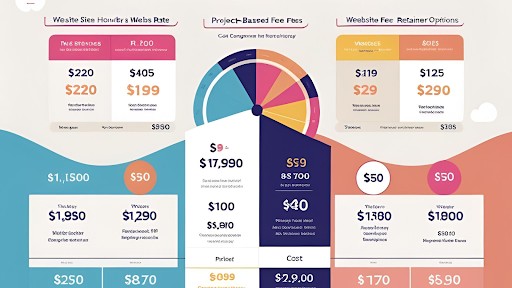I remember the first time I hired a web design agency—it felt like setting out on a grand adventure. I had a vision for my brand, but I wasn’t sure how to bring it to life. The process of selecting the right agency was overwhelming, and, let’s be honest, it’s a little bit like dating. You’re looking for that perfect match, and there are so many options.
But here’s the truth: choosing the right web design agency can make or break your online presence. So, how do you choose a web design agency that will get you the results you’re after? Here’s everything you need to know—from defining your goals and requirements to evaluating portfolios and budget, all with practical tips that’ll make you feel confident in your decision-making.
How to Choose a Web Design Agency?
The key to choosing a web design agency lies in balancing your needs with their expertise. Start by defining your goals and requirements.
Do you need a simple website, a landing page, or a full-scale e-commerce platform? Once you’ve got your goals in mind, it’s time to get into the nitty-gritty. First, you’ll want an agency that’s experienced in the type of website you need—whether that’s a personal blog, a small business site, or an e-commerce platform.
Don’t forget about the technologies they use! You’ll need a design that works seamlessly across all devices, so responsive web design is non-negotiable.
1. Know Your Budget: What Are You Willing to Invest?

Let’s be real: budget plays a huge role in choosing the right web design agency. Before you start your search, figure out what you’re willing to spend. Pricing can vary dramatically based on the complexity of the website and the services you require.
On the lower end, simple websites may cost a few thousand dollars, while custom-built e-commerce platforms can run up to $50,000 or more.
2. Evaluate Their Portfolio: Does It Align with Your Vision?

Now that you’ve got a budget in mind, it’s time to start looking at agencies. A strong, comprehensive portfolio is a must. Check out their past work to see if their style matches your brand’s vibe. Look at the usability of the websites they’ve built: Are they easy to navigate?
Are they visually appealing? More importantly, do they perform well on mobile devices? As you explore their portfolio, pay attention to case studies as well.
Agencies that showcase their case studies usually provide more insight into how they solved specific challenges for clients. This is where you’ll get a sense of their problem-solving abilities and whether they can meet your specific needs.
3. Consider Your Website Requirements: Define Your Goals
Before you start contacting agencies, make sure you’ve clearly defined your goals and website requirements. What are you trying to achieve with your website?
Are you looking to generate leads? Sell products? Share your portfolio? Knowing what you want will help narrow down your options.
4. Look for a Balanced Approach: Aesthetic and Functionality

While aesthetics matter (hello, design trends!), functionality should never be overlooked. A beautifully designed website that’s difficult to navigate is a wasted effort.
A great web design agency strikes a balance between current design trends and user experience.
- Current design trends: Agencies that stay up to date with modern design trends will ensure your website feels fresh and current. Look for designs that incorporate minimalism, bold typography, interactive elements, and dynamic layouts that engage users without overwhelming them.
- User-friendly experience: The most beautiful website is useless if visitors can’t navigate it easily. Make sure the agency you choose prioritizes user experience (UX)—from the layout and load times to the accessibility and responsive design.
How Much Do Agencies Charge for Website Design?

Web design agencies typically charge based on the following:
- Hourly rates: Ranging from $50 to $200 per hour depending on experience.
- Flat fees: A basic website design may cost anywhere from $2,000 to $10,000, while more complex projects could range from $10,000 to $50,000+.
- Ongoing maintenance and updates: Some agencies offer retainer agreements for website upkeep, which might be an added cost.
Be sure to ask upfront about pricing to avoid any surprises down the line. Some agencies might also offer package deals that could be a better fit depending on your needs.
How to Choose a Good Web Designer?
When you start searching for a web design agency, the first thing you need to look for is whether their work resonates with your brand’s personality.
A good designer should be able to take your vision and transform it into a digital masterpiece that’s both aesthetically pleasing and user-friendly.
Here’s how you can choose a good web designer:
- Portfolio: A strong portfolio is the foundation of any good web designer. Look for diverse work that demonstrates their versatility, attention to detail, and creativity. Pay close attention to the designs that align with your preferences.
- Process: The agency should be transparent about their design process. Do they ask the right questions about your business goals? Are they giving you opportunities for feedback throughout the project? Clear communication and regular updates are crucial for a successful partnership.
- Experience with your type of website: Not all designers are suited for all projects. If you need an e-commerce platform, for example, you’ll need someone with specific experience in that area. Make sure the designer’s experience aligns with the type of website you need.
- SEO and User Experience: A good web designer understands that a website should be more than just beautiful—it should also be functional. Ensure they are knowledgeable about SEO (search engine optimization) and UX (user experience) best practices. Your site should load fast, be mobile-friendly, and follow SEO best practices for higher search rankings.
What Are the 4 C’s of Website Design?
There’s a popular framework in web design called the 4 C’s—four key principles that every great website should adhere to. Let’s break them down:
- Clarity: Your website should communicate your message clearly and without confusion. A clear website ensures users understand what your site is about the second they land on it. Navigation should be easy, the content should be easy to read, and the structure should be logical.
- Consistency: Your website design should feel cohesive. Everything—from the fonts and color scheme to the images and buttons—should work together to create a seamless brand experience. Consistency also applies to your tone of voice, message, and overall user experience.
- Conversion: Ultimately, a website should help you achieve your business goals. Whether you’re aiming to generate leads, make sales, or build a subscriber list, the design should guide users toward these actions. This is where strategic placement of calls-to-action (CTAs) comes into play.
- Content: Content is king. But it’s not just about what you say, it’s also about how you present it. Great design allows content to shine, whether that’s through optimized copywriting, high-quality visuals, or videos. Good web designers understand the importance of crafting and positioning content in a way that serves both SEO and the user experience.
How to Set Up a Web Design Agency?
Starting your own web design agency is an exciting endeavor, but it requires a mix of creative talent, business acumen, and organization. Here’s how you can set yourself up for success:
- Identify Your Niche: Whether it’s e-commerce websites, small business sites, or nonprofit designs, focusing on a niche can help you stand out. Specialization makes you more attractive to potential clients who are looking for expertise in specific areas.
- Build a Portfolio: Start by offering free or discounted designs to local businesses, friends, or non-profits. This helps you create a portfolio of work that you can showcase to future clients.
- Market Yourself: Get the word out! Build a professional website, leverage SEO, and actively use social media to promote your services. Attend networking events, collaborate with other designers, and get referrals from happy clients.
- Set Your Pricing: Decide on your pricing structure—hourly, project-based, or monthly retainers. Be transparent with clients about your rates and be sure to value your work appropriately.
- Create a Workflow: Establish processes for how you manage projects, from initial client meetings to design concepts, revisions, and final delivery. Efficient workflow ensures smooth project execution and satisfied clients.
Final Scoop Before You Jump In: Trust Your Gut
Choosing the right web design agency is a process, but it’s also a chance to find a team that aligns with your goals, values, and vision.
Don’t be afraid to ask questions, review portfolios, and ask for testimonials. Your website is a vital part of your brand, and you want to ensure it’s in capable hands. So, take your time, know your budget, and make sure you choose a partner who can turn your vision into reality.
And here’s my final tip: trust your instincts. If the agency feels like the right fit, chances are they’ll deliver the results you’re looking for!
 aspectswebdesign.com
aspectswebdesign.com

